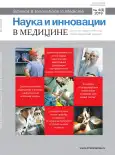Somatic tinnitus: clinical and neurophysiological features
- Authors: Gilaeva A.R.1, Mosikhin S.B.1, Safiullina G.I.1
-
Affiliations:
- Kazan State Medical Academy
- Issue: Vol 4, No 4 (2019)
- Pages: 12-15
- Section: ENT Disorders
- URL: https://ogarev-online.ru/2500-1388/article/view/43741
- DOI: https://doi.org/10.35693/2500-1388-2019-4-4-12-15
- ID: 43741
Cite item
Full Text
Abstract
Objectives – to identify variations in the intensity of tinnitus during the certain motor maneuvers, to evaluate the clinical and neurophysiological features of modulation in patients with tinnitus.
Material and methods. Vertebro-neurological, otorhino-laryngological examinations, audiological and neurophysiological (trigeminal evoked potentials) examinations were carried out in 100 patients with complaints of tinnitus.
Results. In 55% of patients the change in the intensity of tinnitus during various motor maneuvers was registered. The examination of these patients revealed a tendency towards the expression of myofascial disorders, a high burden with ear noise, the low values of compliance according to tympanometry, and the lengthening of the latent periods of peak trigeminal evoked potentials.
Conclusion. The results obtained may indicate the participation of the somatosensory system in the pathogenesis of tinnitus.
Full Text
##article.viewOnOriginalSite##About the authors
Alfiya R. Gilaeva
Kazan State Medical Academy
Author for correspondence.
Email: algi89@mail.ru
ORCID iD: 0000-0002-2941-2717
postgraduate student of the Department of Neurology
Russian Federation, KazanSergey B. Mosikhin
Kazan State Medical Academy
Email: algi89@mail.ru
ORCID iD: 0000-0001-8291-3169
PhD, Professor of the Department of Otorhinolaryngology
Russian Federation, KazanGulnara I. Safiullina
Kazan State Medical Academy
Email: algi89@mail.ru
ORCID iD: 0000-0003-2890-8945
PhD, Professor of the Department of Rehabilitology and sports medicine
Russian Federation, KazanReferences
- Eggermont JJ. The Neuroscience of Tinnitus. Oxford: Oxford University Press; 2012. doi: 10.1093/acprof:oso/9780199605606.001.0001
- Shore S, Roberts LE, Langguth B. Maladaptive plasticity in tinnitus – triggers, mechanisms and treatment. Nat Rev Neurol. 2016;12:150–160. doi: 10.1016/j.heares.2015.06.005
- Levine RA. Somatic (craniocervical) tinnitus and the dorsal cochlear nucleus hypothesis. Am J Otolaryngol. 1999;20:351–362.
- Bhatt JM, Bhattacharyya N, Lin HW. Relationships between tinnitus and the prevalence of anxiety and depression. Laryngoscope. 2017; 27(2):466–9. doi: 10.1002/lary.261075
- Gilaeva AR, Safiullina GI, Mosikhin SB. Trigeminal evoked potentials in patients with tinnitus. Prakticheskaya medicina. 2018;16:(10):97–101. (In Russ.). [Гилаева А.Р., Сафиуллина Г.И., Мосихин С.Б. Тригеминальные вызванные потенциалы у пациентов с тиннитусом. Практическая медицина. 2018;16(10):97–101]. doi: 10.32000/2072-1757-2018-10-97-101
- Kanold PO, Young PO. Proprioceptive information from the pinna provides somatosensory input to cat dorsal cochlear nucleus. The Journal of Neuroscience. 2001;21:7848–58. doi: 10.1523/jneurosci.21-19-07848.2001
- Khabirov FA, Khabirova YuF. Neck and back pain: a guide for doctors. Kazan: Medicina, 2014. (In Russ.). [Хабиров Ф.А., Хабирова Ю.Ф. Боль в шее и спине: руководство для врачей. Казань: Медицина, 2014].
- Michiels S, Sanchez TG, Oron Y, et al. Diagnostic Criteria for Somatosensory Tinnitus: A Delphi Process and Face-to-Face Meeting to Establish Consensus. Trends in Hearing. 2018;22. Available et: URl:https://www.ncbi.nlm.nih.gov/pmc/articles/PMC6144502. doi: 10.1177/2331216518796403
- Frank AJ, Moll JM, Hort JF. A comparison of three ways of measuring pain. Rheumatol Rehabil.1982;21(4):211–217.
- Newman CW, Jacobson GP, Spitzer JB. Development of the Tinnitus Handicap Inventory. Arch. Otolaryngology. 1996;122:143–148.
- Altman YaA, Tavartkiladze GA. A guide to audiology. M., 2003. (In Russ.). [Альтман Я.А., Таварткиладзе Г.А. Руководство по аудиологии. М., 2003].
- Zenkov LR, Ronkin MA. Functional diagnostics of nerve diseases: manual for doctors. 5th edition. M., 2013. (In Russ.). [Зенков, Л.Р., Ронкин М.А. Функциональная диагностика нервных болезней: руководство для врачей. М., 2013].
- Moller A.R. Tinnitus and pain. Prog Brain Res. 2007;166:47–53. doi: 10.1016/s0079-6123(07)66004-x
- Gilaeva AR, Mosikhin SB, Safiullina GI. Relationship of pathology of nose, nasopharynx and neuromuscular dysfunction in patients with tinnitus. Spravochnik vracha obshhej praktiki. 2019;3:35–42. (In Russ.). [Гилаева А.Р., Мосихин С.Б., Сафиуллина Г.И. Взаимосвязь патологии носа, носоглотки и нейромышечной дисфункции у пациентов с тиннитусом. Справочник врача общей практики. 2019;3:35–42].
- Bance M, Makki FM, Garland P. Effects of tensor tympani muscle contraction on the middle ear and markers of a contracted muscle. Laryngoscope. 2013;123:1021–1027. doi: 10.1002/lary.23711
Supplementary files








